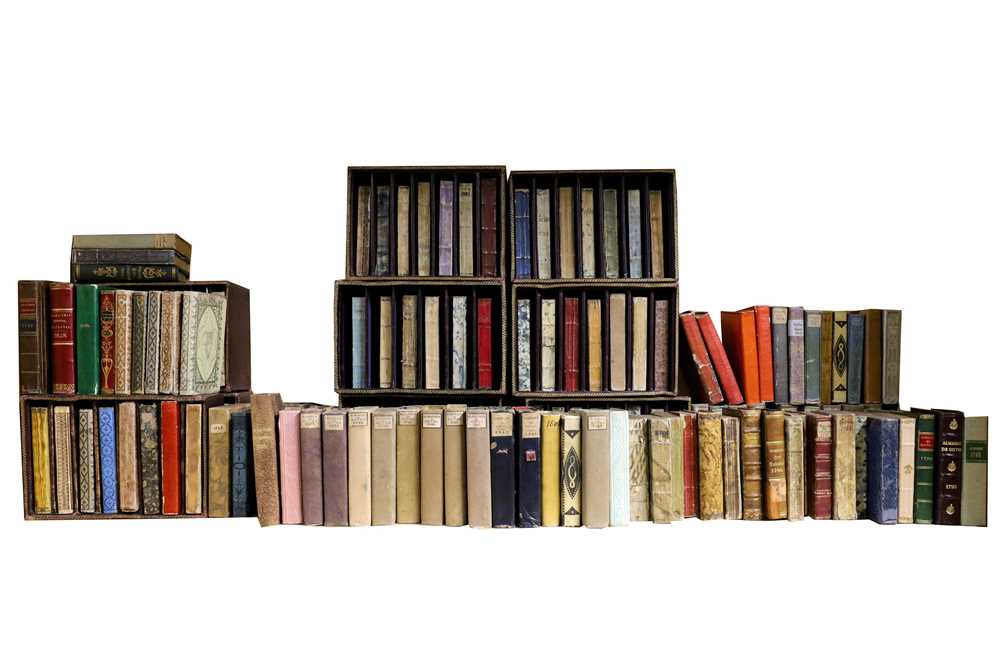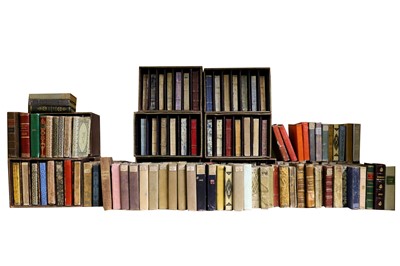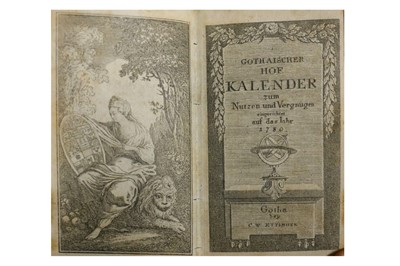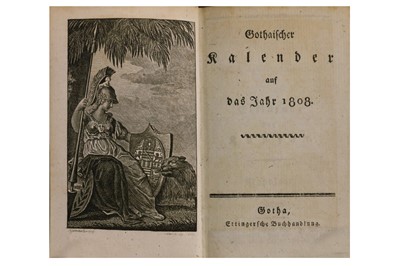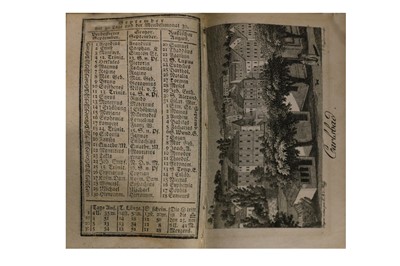2nd Dec, 2020 10:00
Books & Works on Paper | Live Online
Almanach de Gotha.
Almanach de Gotha.-
Almost complete run 1769 to 1945, lacking 1764-1767, 1772, 177, 1779, 171 vol., engraved frontispieces, additional engraved titles and plates, folding tables, occasional spotting, some dust soiling, a few library stamps and bookplates, occasional ownership notes, publisher's pasteboard or printed wrappers featuring different motifs, cloth and calf (all publisher's red cloth after 1871), some volumes within original slipcases, rubbed and soiled, 12mo & 8vo, Gotha, C.W. Ettinger [- Justus Perthes], with a collection of volumes of related interest and duplicates, including, Il corso delle stele osservato dal pronostico moderno. Palma verde almanacco piemontese per l’anno 1726, woodcut frontispiece and device on title, Domenico Amedeo Fontana, Turin, 1726; Almanacco ed Effemeridi per l’anno 1794 & 1796 (Graziosi), Gothalscher Hof Kalender, 1770-1771, 1775, 1777, 1779, 1780-1782, 1785, 1786, 1789, 1792-1798; Almanac Généalogique, 1808 & Annuaire Généalogique et Historique, 1819; Historisch genealogischer Calendar, 1808, 1809, 1814, 1820, 1828, 1831; Calendario Reale per l’anno 1850, 1861 & 1862 (290)
*** The Almanach de Gotha was an annual genealogical, diplomatic, and statistical summary of European royalty, nobility, and key officials and agencies, published in French in Gotha, Germany, continuously from 1763 to 1944. It was first published in French for the year 1764 by Andreas Reyher. After Reyher, various publishers from Gotha took responsibility for the almanac. The Mevius and Dieterich companies were followed by Ettinger, who published the book from 1776 to 1816. Starting in 1770, the German Gothaischer Hof-Kalender was coupled with the Almanac de Gotha. Shortly thereafter, both almanacs were enriched by the addition of copperplates by famous artists such as Daniel Chodowiecki. After 1816, the task was taken over by Justus Perthes, whose name remained on the title page until 1944. The invasion of the Russians during the Second World War brought an abrupt end to the publication of this famous almanac. The Soviets occupied the print shop in Gotha and set fire to the huge genealogical archive. The purpose of the Almanach was to record the ruling houses of Europe and their cadet branches, the most important of those they had ennobled, and incumbent diplomatic corps and highest officers of state. The task was massive, as there were many royal families in Germany and Italy alone, and their minor branches numbered in the thousands. On 20 October 1807, Napoleon, three years after he had been crowned emperor, wrote an angry letter to his minister of Foreign Affairs claiming that the Bonaparte family was the most important in France, not the House of Bourbon. Napoleon ordered the minister to write a letter to his colleague in Saxe-Gotha in order to correct the next year's volume. But the publisher, Karl Wilhelm Ettinger, had already printed the edition for 1808. So he quickly made a special edition for France in which the changes demanded by Napoleon were inserted. The publisher produced two editions: one for France, with the recently ennobled, and another which included dynasties deposed since abolition of the Holy Roman Empire.
Sold for £3,125
Includes Buyer's Premium
Do you have an item similar to the item above? If so please click the link below to request a free online valuation through our website.
